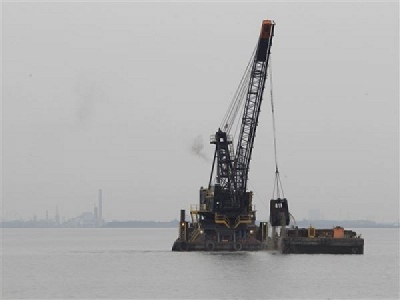
Posted on April 26, 2018
By Roger LaPointe, Sentinel-Tribune
The Ohio Lake Erie Commission met April 18, at which time it approved the Dredge Research and Innovation in Farming Team resolution for researching farming applications with dredged material removed from the Lake Erie channels.
OLEC unanimously approved, by voice vote, the establishment of DRIFT “to advise on the benefits, appropriateness, and effective methods of applying dredged material to farmland in Northwest Ohio.”
“Each year, 1.5 million cubic yards of material is dredged from the federal navigation channels along Ohio’s Lake Erie shoreline. Historically, most of the material dredged from Lake Erie has been placed back into the open waters of the lake,” states the Ohio Environmental Protection Agency website.
OLEC’s David Emmerman listed the three alternative methods of disposing of dredged material, instead of the past method of dumping it in the open (non-channel) waters of the lake. The methods would involve “converting the dredged material to marketable soil, wetlands creation projects and farm field application.”
“The Toledo harbor has the most dredged material coming out of it, in the state of Ohio,” said Emmerman. “Twenty-five percent of the dredged material coming out of the Great Lakes System is coming out of the Toledo harbor.”
The Toledo Lucas County Port Authority recently completed construction of a 10-acre site that will be available for research on farm field application of Lake Erie dredged material.
“The best farm fields in Ohio are under Lake Erie,” Emmerman said, noting he is hoping “to turn what is bad for Lake Erie into what is good for farmland.”
New OLEC member William Wolf asked about possible presence of heavy metals and whether it is all “allowable content” in the dredged material.
“We’re doing a large-scale study, millions of data points, across the lake with all sorts of different constituents, such as metals,” said Emmerman. “Along with that, we have new authority under Senate Bill 2 to establish new rules for established reuse of dredged material or waste reclassification. So when is it appropriate to no longer call dredged material a waste material and deregulate it? So, we are establishing those rules, those thresholds, right now. Additionally, beyond that, we have already in place a permitting program.”
The U.S. EPA defines heavy metals as “a group of highly toxic metals that are generally harmful to plants and animals.” The website further explains in its ToxCast public record, that “human exposure to heavy metals occurs through food contamination due to industrial processes, vehicle emissions and farming methods. Specific toxicity endpoints have been associated with metal exposures, e.g. lead and neurotoxicity; however, numerous varieties of heavy metals have not been systematically examined for potential toxicities.”
Through the enactment of Senate Bill 1, “open-lake disposal will no longer be an option as of July 1, 2020,” as stated on the OEPA website.
Other topics covered included the Lake Erie impairment designation, a discussion covering the Spring 2017 Western Lake Erie Tributary Water Monitoring Summary and the Nutrient Mass Balance Study, Ohio Sea Grant and other projects.
The next OLEC quarterly meeting will be held June 26 from 10 a.m.-noon. The OLEC webpage can be found at http://lakeerie.ohio.gov/
Source: Sentinel-Tribune





